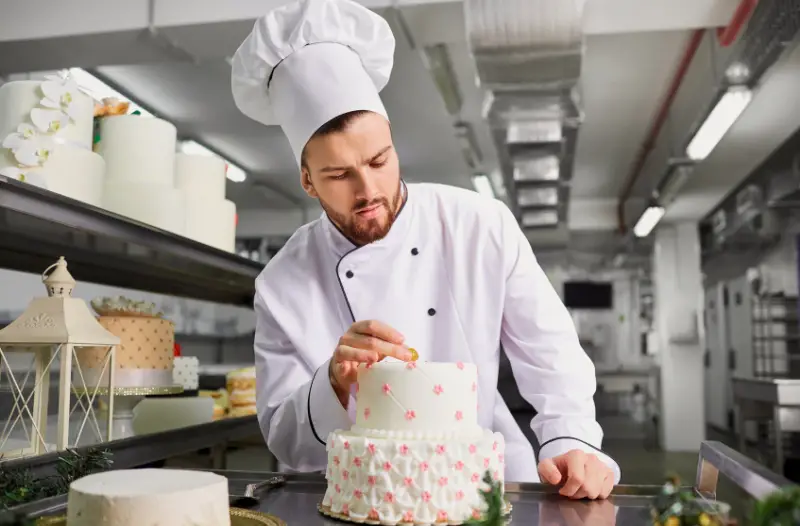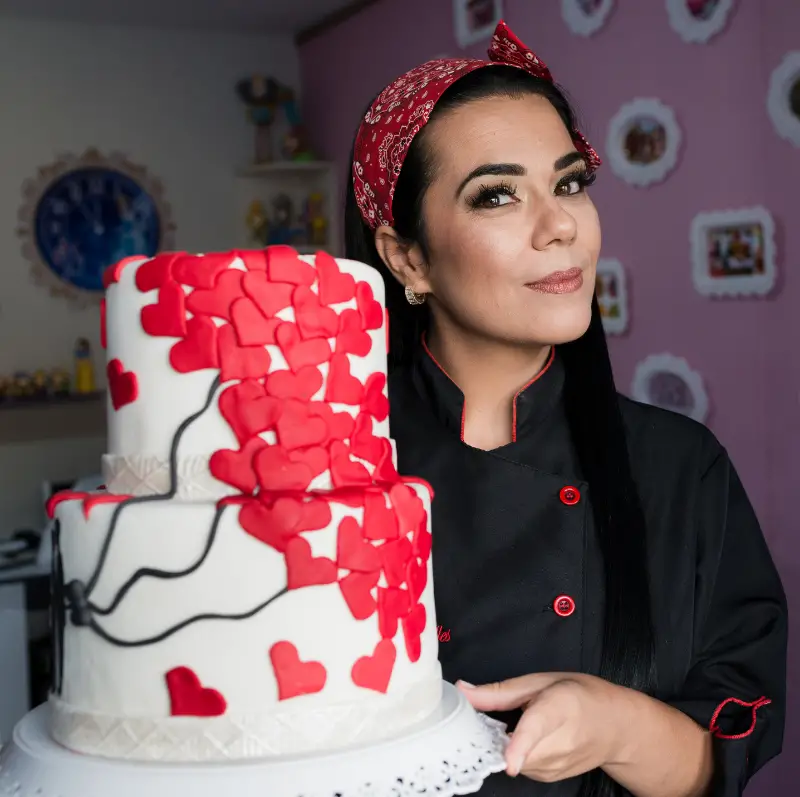A sugar artist creates intricate and delicate edible decorations, sculptures and designs that are visually stunning. They use sugar as the principal agent and employ various techniques such as pulling, blowing, casting, sculpting, piping, painting and moulding of sugar.
Sugar artist often work in pastry arts, wedding and event planning, and culinary arts, using their creativity and expertise to transform sugar into edible art.
This article offers guidance on becoming a sugar artist and developing the skill to transform sugar into artwork. Additionally, it explores the work conditions and career opportunities for sugar artists.
Please read our previous article for more information on what a sugar artist is and what they do.
Table of Contents:
- How To Become a Sugar Artist.
- The Salary of a Sugar Artist.
- The Work Environment and Work Conditions of a Sugar Artist.
- Where Can Sugar Artists Work?
How To Become a Sugar Artist.
Becoming a sugar artist involves artistic skills, technical expertise, and creativity to create intricate and visually stunning edible creations. Here are steps to help you become a sugar artist:
1. Gain Knowledge and Develop Skills.
Gain knowledge and skills in baking, cake decorating, and sugar art techniques. You can learn through books, online courses, or working with an experienced sugar artist.
To acquire knowledge and develop your sugar artistry skills, you need to:
Learn the Basics of Baking:
- Begin by learning the fundamentals of baking, including techniques for working with dough, cake batter, and other baked goods.
Learn Sugar Crafting Techniques:
- Learn sugar art and crafting techniques, including sugar lace, spun sugar, cast sugar, pulled sugar, and blown sugar, working with fondant, gum paste, royal icing, and modelling chocolate.
- Develop sugar flower crafting, cake sculpting, airbrushing, and hand-painting skills.
- Practice creating different types of sugar art and experimenting with different shapes, colours, and textures to enhance the visual appeal of your creations.

Study Design Principles:
- Learn about design principles, colour theory, and visual aesthetics to create visually pleasing sugar art.
Attend Sugar Art Workshops:
- Attend workshops, seminars, and classes conducted by experienced sugar artists. These provide hands-on learning and exposure to advanced techniques.
2. Get Experience Working With an Experienced Sugar Artist.
Gain experience working in a bakery or pastry shop, specialising in creating custom cakes and confectionery sculptures. You can also start by working as a baker’s assistant to learn the basics of baking and cake decorating.
3. Obtain Formal Education in Cake Decorating And Sugar Art.
Consider obtaining formal education in baking and pastry arts or a related field. This can give you a solid foundation in baking techniques and help you develop the skills needed to become a sugar artist.
Enrol in culinary arts courses offering specialised training in cake decorating and sugar artistry, and look for programs focusing on advanced techniques.
4. Obtain Certification From Professional Organisations.
Consider obtaining certification from a professional organisation, such as the International Cake Exploration Societé (ICES), which offers a Certified Master Sugar Artist (CMSA) program. This can help demonstrate your expertise and credibility as a sugar artist.
5. Build a Portfolio to Showcase Your Skills.
Create a portfolio of your work with high-quality pictures of your sugar art creations. This can help showcase your skills and experience. As you progress, your portfolio will showcase your growth and abilities to potential clients and employers.
6. Find Employment or Start Your Own Business.
Look for employment opportunities in bakeries, pastry shops, restaurants, hotels, catering companies, or as an independent contractor. You can also consider starting your own sugar art business.
7. Continue Learning and Grow Your Career.
Continue Learning by attending workshops, conferences, or online courses and staying current with the latest sugar art techniques and trends. This can help you continue to develop your skills and remain competitive in the industry.
The Salary of a Sugar Artist.
From data on sites like Indeed, Zippia, and Glassdoor, the salary of a sugar artist in the United States can vary widely depending on location, experience, and employer. However, based on the search results, sugar artists can, it seems, earn relatively high salaries. Bear in mind that individual wages can vary.
The following table was created from salary information from the above sites, available when writing this article.
Average Salary for a Sugar Artist in the US.
| Average Annual Salary | $62,743 |
| Salary Range | $36,000- $152k per year |
The Work Environment and Work Conditions of a Sugar Artist.
The conditions under which a sugar artist works can vary based on their work environment, projects’ nature, and individual preferences. Here are some situations that may apply to a sugar artist’s work:
Work Environment: Studio, Bakery, Home or Commercial Kitchen.
Many sugar artists work in a dedicated studio or commercial kitchen space. This environment is equipped with specialised tools and equipment for sugar crafting.
Some sugar artists operate from their own kitchens or home-based studios. This can offer flexibility but might have limitations in terms of space and equipment.
Sugar artists may work as part of a larger bakery team, focusing on creating elaborate cake decorations and custom orders.
Work With Sugar and Sugar-Based Ingredients.
Sugar artists work with sugar and sugar-based ingredients. When working with sugar, artists often heat it to high temperatures to melt and manipulate it into different shapes. This molten sugar can be extremely hot and requires careful handling to avoid burns.
Additionally, melted sugar has a sticky consistency that can make it challenging to work with. It requires skill and precision to shape it into the desired forms before it cools and hardens.
They must have a high level of skill, patience, and attention to detail to work with molten sugar effectively while ensuring their safety.

Work in Hot and Humid Conditions.
Sugar artists may work in hot and humid conditions, mainly when working with hot sugar. This can pose challenges due to the increased likelihood of sugar melting and becoming sticky. Sugar artists must adapt their techniques and working environment to maintain their creations’ desired consistency and shape.
This may involve adjusting the temperature of their workspace, using specialised tools to control humidity levels, and working quickly to prevent the sugar from becoming too soft.
Additionally, sugar artists may need to adjust their recipes or techniques to suit the prevailing environmental conditions better and ensure consistent results.
Work in a Clean and Organised Space.
Working in a clean and organised environment is essential for sugar artists to ensure that their confectionery sculptures are high quality.
A clean and hygienic workspace helps to prevent contamination and ensures that sugar creations are safe for consumption.
Working in an organised space, with tools, moulds and equipment readily available, ensures efficient and precise work, reducing mistakes in sculpting delicate pieces and reducing the risk of accidents or injuries while working with hot sugar and sharp tools.
A Varied Work Schedule Based on Demand.
Sugar artists frequently experience fluctuating work hours, adjusting their schedules to meet project deadlines.
This flexibility may entail early mornings, late nights, and even weekend work to ensure timely completion. Adapting to these variable hours demands dedication and a willingness to accommodate the demands of each project, often requiring artists to balance their personal and professional lives accordingly.
Workload Fluctuates According to Seasonal Demands.
The workload of sugar artists can vary significantly and be seasonal. During special occasions like weddings or birthdays and holidays like Christmas or Valentine’s Day, artists may face a surge in orders and tight deadlines. Conversely, quieter periods may allow more experimentation and skill development time.
Managing these fluctuations requires effective planning, communication with clients, and adapting to changing demands while maintaining the quality of their creations.

Create Unique and Visually Appealing Designs.
The work environment of a sugar artist requires strong imagination and artistic flair as sugar art is a highly creative field; sugar artists must continually create unique and visually appealing designs for their confectionery sculptures.
This creative process involves experimenting with different techniques, colours, and textures to create unique and visually stunning pieces.
Manage Time Effectively to Meet Deadlines.
Sugar art can be a time-consuming process, so sugar artists must be able to manage their time effectively to meet deadlines. They must be able to plan their work and prioritise tasks to ensure that their confectionery sculptures are completed on time.
Detail Orientation, Precision and Patience for Aesthetics.
Sugar artists rely on their keen detail orientation to craft intricate decorations, sugar flowers, and delicate patterns that enhance the aesthetic appeal of cakes and desserts.
Precision is paramount in replicating real-life textures and forms, such as lifelike flowers or intricate lacework, ensuring that the sugar art creations are visually convincing and realistic.
Many sugar art techniques are time intensive and require patience, such as gradually building sugar flower petals or meticulously piping intricate patterns, resulting in stunning and precise edible masterpieces.

Stress from Example, Project Volume or Design Complexity.
Sugar artists often experience elevated stress levels during peak seasons due to high orders and tight deadlines, requiring effective time management and stress-coping strategies.
The intricate nature of sugar artistry demands meticulous attention to detail, which can contribute to stress as artists strive for precision in sculpting, piping, and decorating, particularly for elaborate custom designs.
Physical Demands in Fine Motor Skills and Prolonged Standing.
Sugar artists rely heavily on their fine motor skills to shape, mould, and manipulate sugar mediums, requiring steady hands and precise movements.
Sugar artistry often involves prolonged periods of standing, which can strain the legs, feet, and back, emphasising the importance of ergonomic workspaces and breaks.
Closely Engaging Clients for a Good Customer Experience.
Sugar artists work closely with clients to understand their design preferences, ensuring that the final product meets their expectations.
Sugar artists may have to engage customers to understand their preferences, needs, and event themes, ensuring that the final creations align with the client’s vision and deliver exceptional customer service for a positive client experience and repeat business. Clients often value being consulted and the experience of working with the sugar artist.
Where Can Sugar Artists Work?
Sugar artists have a diverse range of options for finding work opportunities. They can work anywhere where sugar art is needed to create edible, aesthetic sugar showpieces, centrepieces, special event cake decorating, and other decorative elements for special events, like weddings and birthdays. Sugar artists can work at wedding and cake shops, hotels, restaurants, catering and event companies.
Here are some places where sugar artists can find employment or establish their own businesses:
Custom Cake Studios and Bakeries: Sugar artists can work in cake studios or bakeries that specialise in creating custom cakes and confectionary sculptures, elaborate and artistic cakes. They may focus on designing and crafting intricate cake decorations, sculpted cake toppers, and sugar flowers for special events.

Pastry Shops: Sugar artists can find employment in pastry shops specialising in creating high-end desserts and confectionery
Wedding Boutiques: As Sugar art is commonly used to decorate cakes, adding intricate designs, flowers, and other decorative elements to enhance the visual appeal of the cake, sugar artists can collaborate with bridal boutiques to offer custom-designed wedding cake options as part of their services.

Catering and Event Planning Companies: Catering services and Event planning companies may use sugar artists to design and create custom cake and dessert displays for weddings, corporate events, and other special occasions that align with their clients’ event themes.
Restaurants, Hotels and Resorts: Upscale hotels and resorts with banquet and event services may have in-house pastry departments and use sugar artists to create show-stopping desserts for their guests and sugar showpieces for dessert buffet displays.
Culinary Schools and Workshops: Experienced sugar artists can teach their techniques at culinary schools, community centres, and workshops, sharing their knowledge with aspiring artists.
Entrepreneurship: Many sugar artists choose to start their own businesses. They can establish cake-decorating studios, create online shops, or offer their services as independent contractors for various events. They provide custom cake and dessert creations directly to individuals for weddings, birthdays, anniversaries, and other personal celebrations.

As an entrepreneur, sugar artists might collaborate with other artists, such as event designers, florists, and photographers, to create cohesive visual experiences for events.
Independent sugar artists can build their brand by gaining recognition through participating in cooking and baking competitions on television shows or by showcasing their work in food-related media.
In some cases, sugar artists may be able to showcase their work in galleries, exhibitions, and food-related events as edible art installations.


